I’ve been a student for my entire life and how I learn has changed. I don’t think I am alone in this as the strategies that students use to learn new material can be surprisingly diverse. Some students might space out their studies, others will cram the night before. Some may explain details scribbled in their journals while others highlight their textbooks until they are as colourful as a rainbow. Some of my friends swear by mnemonics or describe the visual images they’ve painted in their head to keep complex information organized. I know I too have relied on some of these same techniques as a learner.
The QEP includes “Adopts effective work methods“ as a Cross-Curricular Competency in the Elementary and the Secondary programs. In other words, students are expected to develop an ability to learn effectively.
After many years spent reflecting on learning, I find myself asking: Which learning techniques show more benefits for learners than others and how do we know this?
Over the years, researchers in cognitive and educational psychology have been amassing evidence about effective learning techniques. Their focus has often been trained on cognitive skills such as memory, perception, problem solving, and comprehension (note: this is not the only way to study education or learning strategies). These studies can often lead to thought-provoking conversations among professionals because they offer an analytical and detached perspective (for all its faults and benefits). This post is about one such meta-analysis. Researchers were keen to identify techniques that students could readily use to better regulate their own learning. They also wanted to assess techniques that students may substantially rely upon.
The table below is a visual guide that summarizes the findings of Dunlosky et al. (2013).
Green = Very generalizable; Yellow = Somewhat generalizable; Red = Not generalizable
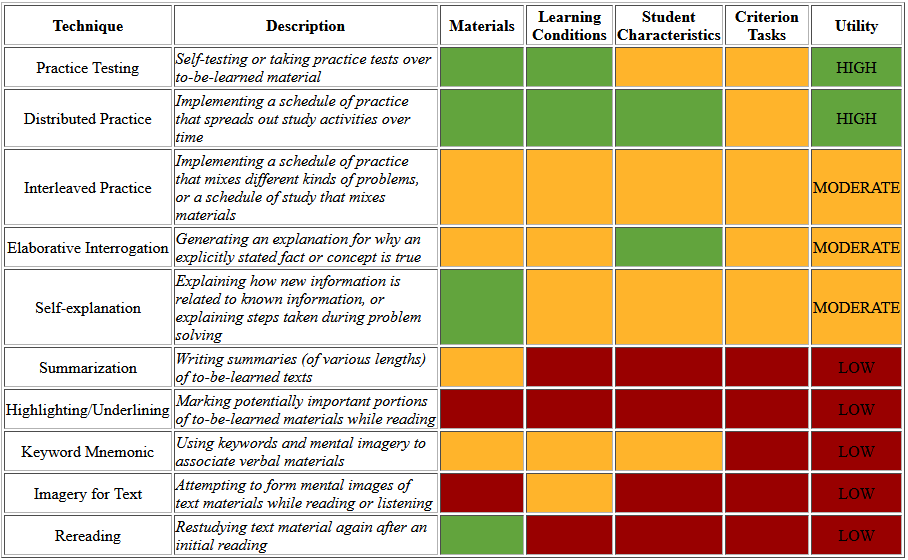
You can read about any learning technique in any order down below. This blog post describes in some detail how each learning technique fared in each of the research categories used by researchers.
These categories provide a metric on how generalizable the learning technique is. For instance, does highlighting work for a wide variety of students or materials? What about the students’ characteristics or the conditions in which they are learning? Each category is used to assess the overall utility of the learning technique. Some are rated high because they are very generalizable: They work for a wide array of students, in many different educational contexts, for different types of assessments, and subject areas. Each research category has been defined below as a set of terms.
Research Categories
| Materials | Learning Conditions | Student Characteristics* | Criterion Tasks |
| Vocabulary | Amount of practice (dosage) | Age | Cued recall |
| Translation equivalents | Open- vs. closed-book practice | Prior domain knowledge | Free recall |
| Lecture content | Reading vs. listening | Working memory capacity | Recognition |
| Science definitions | Incidental vs. intentional learning | Verbal ability | Problem solving |
| Narrative texts | Direct instruction | Interests | Argument development |
| Expository texts | Discovery learning | Fluid intelligence | Essay writing |
| Mathematical concepts | Rereading lags** | Motivation | Creation of portfolios |
| Maps | Kind of practice tests*** | Prior achievement | Achievement tests |
| Diagrams | Group vs. individual learning | Self-efficacy | Classroom quizzes |
“* = Some of of these characteristics are more state based (e.g., motivation) and some are more trait based (e.g., fluid intelligence); this distinction is relevant to the malleability of each characteristic, but a discussion of this dimension is beyond the scope of this article.
** = Learning condition is specific to rereading.
*** = Learning condition is specific to practice testing,” (p.6).
Use the links in the menu below to navigate and the “go to top” links at the bottom of each section to return here
Elaborative interrogation | Self-explanation | Summarization | Highlighting/underlining | Keyword mnemonic |
Imagery for text | Rereading | Practice testing | Distributed practice | Interleaved practice
1. Elaborative interrogation
 Generating an explanation for why an explicitly stated fact or concept is true. When students generate answers to “why” questions, new information is integrated more easily into their current understanding. However, assessing the accuracy and salience of details is key.
Generating an explanation for why an explicitly stated fact or concept is true. When students generate answers to “why” questions, new information is integrated more easily into their current understanding. However, assessing the accuracy and salience of details is key.
Materials: Effects are relatively robust across a wide range of factual materials, including facts about animals, geography, science concepts, retail, etc. However, may only be applied to discrete units of factual information.
Learning Conditions: Effects shown using incidental or intentional learning instructions (possibly stronger effects for latter). Effects shown in individual learners, as well as dyads and small groups.
Student Characteristics: Effects across wide range of students, including younger learners (4th-6th grade), middle school, high school, and undergraduate. Mixed results or no effects for our youngest learners. Students with learning disabilities may benefit as well (4th-12th grade). However, prior knowledge moderates the effects and may not benefit lower-knowledge learners.
Criterion Tasks: Majority of research based on cued recall (“Which animal…?”) and matching (choose correct pair of animal and fact). Effects shown on fact recognition as well. However, the length of retention between task and assessment for long periods of time still needs further research.
Overall Utility – Moderate: While elaborative interrogation tasks require minimal training from students and can be used across a broad range of factual topics and ages, their applicability is narrow. Students may also require direction about which kinds of content elaborative interrogation may be applied upon. Benefits may also be limited for learners with low levels of domain knowledge. While effects are established for short delays, retention over a long period of time remains unconfirmed.
2. Self-explanation
 Explaining how new information is related to known information, or explaining steps taken during problem solving. When students explain some aspect of their processing during learning, it may enhance learning by incorporating new information into their present understanding. A wide range of tasks and measures have been studied as well as a wide variety of prompts. As such, summarizing the underlying mechanisms remains elusive.
Explaining how new information is related to known information, or explaining steps taken during problem solving. When students explain some aspect of their processing during learning, it may enhance learning by incorporating new information into their present understanding. A wide range of tasks and measures have been studied as well as a wide variety of prompts. As such, summarizing the underlying mechanisms remains elusive.
Materials: Self-explanation is broadly applicable with effects being shown across several different task domains. Some examples include: learning from short or longer expository texts, helping younger learners overcome some misconceptions, and various math problems for younger learners. However, most research has involved procedural or problem-solving tasks.
Learning Conditions: Some effects observed when paired with direct instruction or discovery learning. Retrospective self-explanation was better than none at all but not as effective as concurrent self-explanation. However, access to correct answers or explanations may significantly diminish effects on learners.
Student Characteristics: Effects shown with younger and older learners, including as young as kindergartners and as old as undergraduates. However, effects across different levels of prior knowledge or ability requires more research.
Criterion Tasks: Effects have been shown on a wide range of criterion measures, including standard measures of memory (i.e. cued recall, multiple-choice tests, etc.) and tasks in which inference from the text is required. Nearly all succeed in near-transfer cases and some math problems and pattern learning demonstrate far transfer. However, the durability of effects has not been explored and remains a mystery.
Overall Utility – Moderate: Effects across a wide range of content materials, task domains, and age groups represent this learning technique’s strengths. How long these effects are retained remains to be understood. Students may benefit from some support on how to self-explain. Finally, self-explanation takes time and may not be worth the opportunity cost.
3. Summarization
 Writing summaries (of various lengths) of to-be-learned texts. Due to the breadth of tasks that summarization can take, it is difficult to generalize. Researchers focus more on how to improve students’ ability to summarize rather than identifying which type of summary is most effective. Higher quality summaries are generally associated with better recall of main ideas.
Writing summaries (of various lengths) of to-be-learned texts. Due to the breadth of tasks that summarization can take, it is difficult to generalize. Researchers focus more on how to improve students’ ability to summarize rather than identifying which type of summary is most effective. Higher quality summaries are generally associated with better recall of main ideas.
Materials: Researchers in the past have pointed to the possible impact that text length, readability, and organization may have on a student’s ability to benefit from a summary. However, studies that investigate these factors thoroughly using systematic controls are still needed.
Learning Conditions: Due to the variety of summaries (short v. long) as well as the variety in student abilities and materials, the most effective conditions for summarizing are in dispute. Whether the text should be present (to aid success at finding important info) or absent (to stimulate recall in students) remains unanswered.
Student Characteristics: Benefits have mostly been observed in undergraduate students. Some younger students (i.e. middle school) may benefit from summarization following extensive training in which direct instruction is used to model how to summarize. However, while students with more interest or knowledge in a topic may benefit from this technique, domain experts may find the task redundant.
Criterion Tasks: Most studies have used multiple-choice, cued recall, or free recall questions when assessing benefits. However, results are mixed and not robust. While summarization may benefit students’ later performance on generative measures and benefits may remain robust after weeks, these results are preliminary and/or specific to lab conditions.
Overall Utility – Low: This technique is effective for those already skilled at summarizing (especially older students). Younger learners require somewhat extensive training in order to use this skill effectively and this raises questions about opportunity cost when other techniques have more robust findings about their benefits, such as self-questioning or generating explanations.
4. Highlighting/underlining
 Marking potentially important portions of to-be-learned materials while reading. Learners often prefer these techniques because they are easy to use (often without prior training), and do not require extra effort beyond reading. Due to the isolation effect, words or phrases that “pop” will be memorable.
Marking potentially important portions of to-be-learned materials while reading. Learners often prefer these techniques because they are easy to use (often without prior training), and do not require extra effort beyond reading. Due to the isolation effect, words or phrases that “pop” will be memorable.
Materials: A variety of text materials on a diversity of topics have been studied with many researchers coming to a similar conclusion that underlining was ineffective regardless of the length of the text.
Learning Conditions: Researchers could not include this section of the review for this set of learning techniques due to the lack of relevant evidence. Therefore, the generality of the benefits is largely moot.
Student Characteristics: Highlighting has failed to benefit a wide range of student populations, including Air Force basic trainees, children, and remedial students. Domain knowledge is an important modifier as students with little knowledge on a subject may struggle to isolate important info from the text. Students may also have the ability to highlight effectively but do not do so.
Criterion Tasks: Few benefits, if any, have been observed on immediate and delayed tests. Even more concerning, if students review their marked-up texts prior to assessment, underlining may disadvantage them if questions rely on inference rather than recollection of specific facts. More research is needed to explain this relationship.
Overall Utility – Low: In most situations, highlighting does not boost performance. It may benefit knowledgeable students who can discern relevant information from irrelevant but may actually impede the ability to infer. Given that students will likely continue to use this technique, research is needed to determine how to better utilize this technique.
5. Keyword mnemonic
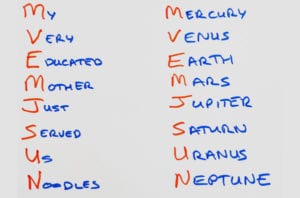 Using keywords and mental imagery to associate verbal materials. One of the most investigated mental activities, researchers have observed benefits in learners who integrate new concepts into familiar verbalizations, especially when mental images are interactive and elaboration can occur.
Using keywords and mental imagery to associate verbal materials. One of the most investigated mental activities, researchers have observed benefits in learners who integrate new concepts into familiar verbalizations, especially when mental images are interactive and elaboration can occur.
Materials: Mnemonic devices can benefit students learning keywords in a variety of languages. For instance, learning definitions of scientific terms or concrete facts about particular objects may benefit students. However, not all words can be visualized, particularly abstract terms.
Learning Conditions: Most studies involve experimenters providing learners with keywords and interactive images directly to students. Research involving the generation of keywords by students had mixed results. Younger learners especially may need images during learning to form meaningful connections between the concept and the mnemonic device.
Student Characteristics: Students of a wide range of ages can benefit from the keyword mnemonic technique, making it a popular choice. However, some keywords are abstract or are difficult to work into imagined scenes, especially for younger learners.
Criterion Tasks: Successful retrieval of new information over a long period of time using mnemonic techniques is shrouded in doubt. Over a long enough period of time, the keyword mnemonic may even lead to ‘accelerated forgetting’ due to the difficulty of recalling which target concept the mnemonic was intended to support.
Overall Utility – Low: Researchers can not recommend that this technique be widely adopted. While it may serve some purpose with keyword-friendly materials, it is inefficient and likely not durable. Other techniques, such as practice testing, are easier and more broadly applicable. Further research is required to determine if mnemonics benefit students when they are the ones to generate them.
6. Imagery for text
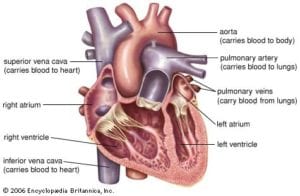 Attempting to form mental images of text materials while reading or listening. When digesting new information, mentally imagining the content may be more beneficial than reading for comprehension or drawing. Training is minimal, may involve inference, and may handle complex content.
Attempting to form mental images of text materials while reading or listening. When digesting new information, mentally imagining the content may be more beneficial than reading for comprehension or drawing. Training is minimal, may involve inference, and may handle complex content.
Materials: Research has focused on texts that can be easily visualized – in particular, narratives with concrete details. However, benefits did not extend to recall of more abstract texts and may only be apparent when students listen rather than read the text. Effects on reading comprehension are also in doubt or non-existent.
Learning Conditions: The modality of instruction may be vital to the success of this technique: visualizing while listening to a text may be more beneficial than visualizing while reading. Furthermore, students may be instructed to visualize while reading but not necessarily do so.
Student Characteristics: This technique has been studied across a wide range of ages, especially with fourth graders. In some studies, some benefits were seen for free-recall of longer narratives but saw no benefit to reading comprehension. The inconsistency of effects is also visible in other age groups and can depend upon the type of criterion test used.
Criterion Tasks: When learners are asked to freely recall factual or concrete information after being given visual imagery instructions, they may benefit more than being given reading instructions. However, no benefits have been observed on tests for comprehension or application of new information. Moreover, long-term durability of benefits is still an open question.
Overall Utility – Low: Some learners may benefit from the use of imagery while learning from a text. These benefits are constrained to imagery-friendly texts, and while being more broadly applicable than mnemonics, the benefits are reflected only on tests of memory. Further research is required across different criterion tasks and over longer periods of time to test for the durability of benefits.
7. Rereading
 Restudying text material again after an initial reading. Rereading is one of the most popular learning techniques used by students. The quantitative hypothesis supposes that learning is improved due to an increase in the total amount of info encoded. The qualitative hypothesis supposes that rereading allows lower- and higher-level information to be synthesized with each reading.
Restudying text material again after an initial reading. Rereading is one of the most popular learning techniques used by students. The quantitative hypothesis supposes that learning is improved due to an increase in the total amount of info encoded. The qualitative hypothesis supposes that rereading allows lower- and higher-level information to be synthesized with each reading.
Materials: Rereading effects are robust for materials that vary widely in terms of length and content. Many content domains have been covered, including topics in physics, law, history, technology, geography, and psychology.
Learning Conditions: Learners may benefit from rereading when they are forewarned they will have such an opportunity. When rereading is moderately spaced (from a lag of minutes to 2 days or a full week), it appears to be more effective than rereading in a single setting and can withstand interference from other subjects. However, benefits are significantly reduced from the third reading on.
Student Characteristics: Research very limited – nearly all based on undergraduate students. The benefits of rereading as they relate to the levels of knowledge learners bear is underexplored and the same can be said for the influence of a learner’s ability (such as higher or lower working-memory spans) on any possible benefits.
Criterion Tasks: Free recall, the most studied task, has consistently shown effects whether rereading is spaced or not. Other recall tests based on factual information also see positive effects. However, the evidence in favour of benefits for comprehension and recognition tasks are unclear, with effects mediated by numerous factors such as ability.
Overall Utility – Low: While rereading can be applied to a wide variety of texts and is easy for students to adopt, its effects are consistently inferior to other learning techniques in direct comparisons. Moreover, nearly all research is based on undergraduate students and few studies have systematically assessed the effects of knowledge or ability on this technique. Durability may be improved by spacing but effects are restricted to memory-recall tasks. Its inefficacy in comparison to other learning techniques is a major reason for its low scoring.
8. Practice testing
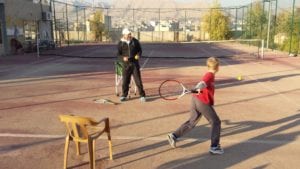 Self-testing or taking practice tests over to-be-learned material. Researchers emphasize that practice testing is distinguished by its low stakes or by a student’s ability to engage in it autonomously. This distinction is made in contrast with summative assessments given by instructors. Students may benefit from practice tests, particularly when correct answers do not reappear. Rationales for why these effects exist are still being formulated and discussed.
Self-testing or taking practice tests over to-be-learned material. Researchers emphasize that practice testing is distinguished by its low stakes or by a student’s ability to engage in it autonomously. This distinction is made in contrast with summative assessments given by instructors. Students may benefit from practice tests, particularly when correct answers do not reappear. Rationales for why these effects exist are still being formulated and discussed.
Materials: Many studies have demonstrated effects using simple verbal materials, such as word lists and paired associates. Effects have been primarily demonstrated using factual information or declarative knowledge as a metric. Most of the materials was relevant to educational contexts, involving translation tasks, trivia facts, and facts drawn from science, history, and psychology, for example.
Learning Conditions: Effects have been observed in many memory recall tests, including free recall, short-answer questions, and fill-in-the-blank questions. While most studies focus on memory recall, some effects have been observed in tests that tap comprehension, such as multiple-choice inference-based questions. The science tentatively suggests that practice tests which require more generative responses are more effective. In terms of dosage, multiple tests are better than one, with the timing between tests being an important factor: the longer, the better.
Student Characteristics: A large majority of studies have involved undergraduates, although effects have been demonstrated across a wide variety of ages, including kindergarteners, elementary, middle, high, and 3rd- and 4th-year medical-school students. However, few studies have reviewed knowledge or ability as mediating factors.
Criterion Tasks: For most of the research, cued recall was the most commonly used. Other forms of memory tests have also demonstrated effects. Many studies have also shown that benefits transfer across different test formats.
Overall Utility – High: Practice testing has broad applicability due to effects being demonstrated across a wide range of formats, types of material, ages of learners, outcome measures, and retention intervals. There are gaps in the research as it pertains to the characteristics of learners.
9. Distributed practice
 Implementing a schedule of practice that spreads out study activities over time. While many students may prefer to mass their studying during a single period (i.e. ‘cramming’), research shows that the long-term retention of new information is improved when students spread out their studying.
Implementing a schedule of practice that spreads out study activities over time. While many students may prefer to mass their studying during a single period (i.e. ‘cramming’), research shows that the long-term retention of new information is improved when students spread out their studying.
Materials: Effects have been observed with many types, including face-name pairs, translations of foreign vocab words, trivia facts, texts, lectures, and pictures. A range of domains have yielded positive results as well. However, for tasks that are very complex, benefits were not as robust.
Learning Conditions: This technique is specific more to scheduling of a learning experience rather than the qualities of the experience itself. While longer gaps between sessions yield better effects, longer lags are not always better. How long students were expected to remember something was an important factor. Generally, the best effects were when the lag between sessions was 10-20 percent of the total time students were to retain the information.
Student Characteristics: The majority of studies have focused on undergraduates however, it can be generally stated, that learners of all ages benefit. However, the effects of learner characteristics such as knowledge and motivation remain unexplored.
Criterion Tasks: Effects have been generalized beyond free recall to include multiple-choice questions, cued-recall and short-answer questions, frequency judgments, and sometimes, implicit memory. However, it cannot be said that effects will generalize to all other educationally relevant measures. This gap is the largest for research on distributed practice.
Overall Utility – High: This learning technique is easy to implement and has been utilized successfully in numerous classroom studies. It shows benefits for learners over long delays, with a wide variety of materials, on most standard lab measures, and for students of nearly any age.
10. Interleaved practice
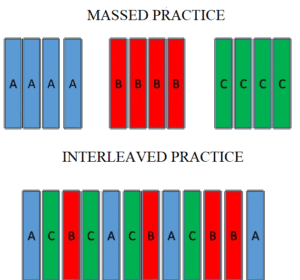 Implementing a schedule of practice that mixes different kinds of problems, or a schedule of study that mixes different kinds of material, within a single study session. Research is still emerging but shows promising benefits for interleaved practice compared to blocking (studying subject by subject). One possible reason this helps is because students are able to practice discriminating between selecting the correct solution method.
Implementing a schedule of practice that mixes different kinds of problems, or a schedule of study that mixes different kinds of material, within a single study session. Research is still emerging but shows promising benefits for interleaved practice compared to blocking (studying subject by subject). One possible reason this helps is because students are able to practice discriminating between selecting the correct solution method.
Materials: A wide variety of materials have been tested, ranging from simple to relatively complex, with outcomes being mixed. Interleaving appears to not improve retention of new vocabulary terms whereas some promising results have been observed in math subjects like Boolean functions and algebraic skills. Research points towards learner’s improvements in handling novel scenarios. However, it is possible that when items within a category are dissimilar, blocking would be superior to interleaving as students can identify similarities that define the category.
Learning Conditions: Interleaved practice shares similarities with distributed practice due to its emphasis on scheduling but its effects have been distinguished from the effects of spacing. Some effects have been observed and are attributed to the discriminative-contrast hypothesis, in one study, students could more easily discern an artist’s style when those different concepts were presented simultaneously. However, there is an open question as to how much initial practice with a new concept is sufficient before interleaving it with other concepts, especially for younger learners.
Student Characteristics: A majority of studies focused on undergraduates and effects are mixed with some studies showing results and others not. With younger learners, there was similarly mixed results with some fifth and sixth graders benefiting during a course on fractions while in another study, high school students with higher skill levels at using commas correctly were actually impeded rather than improved.
Criterion Tasks: This section largely mirrors the discussion of materials. In terms of retention intervals, most studies employed minimal delays between practice and criterion tests. Some have shown retention for as long as one to two weeks. However, others were unable to show benefits over the longer retention intervals used in their study.
Overall Utility – Moderate: Benefits are robust in mathematical courses, where learning and retention was improved dramatically. Interleaving helps other cognitive skills and rarely hinders. However, the research is not extensive and is in need of systematic reviews.
My colleague Chris Colley has written a lovely post about interleaved practice over here
Come back if you see a learning technique pop up in the wild or post some questions in the comments area below. I’d love to hear your thoughts. If you would like to dig into the source material, the paper is called Improving Students’ Learning With Effective Learning Techniques: Promising Directions From Cognitive and Educational Psychology.
References
Braxmeier, H. (2014, February 23). Glasses-read-learn-book-text. Pixabay.com. https://pixabay.com/photos/glasses-read-learn-book-text-272401/.
Concentrated Practices vs. Distributed Practice (n.d.). https://nikolaibull-learning-environment.weebly.com/3practice-methods.html. Retrieved 10 February 2021.
Dunlosky, J., Rawson, K., Marsh, E., Nathan, M., & Willingham, D. (2013). Improving students’ learning with effective learning techniques: Promising directions from cognitive and educational psychology. Association for Psychological Science, 14(1) pp.4-58. https://doi.org/10.1177/1529100612453266.
Firm Foundations Duhok (2016, December 08). Tennis coach in duhok teaches forehand. https://commons.wikimedia.org/wiki/File:Tennis_coach_Practice_Makes_Perfect.jpg.
Guillemette, S., Vachon, I., & Guertin, D. (2020). Framework for competent action in educational consulting: Fostering student success – For pedagogical consultants in the Quebec school system. (P. Strauss, Trans.). Montréal, QC: Les Éditions JFD inc.
Encyclopaedia Britannica, Inc. (n.d.). Human heart. Britannica.com. https://www.britannica.com/science/heart.
Johnson, G. (2020, January 22). Owl-reading-book-bird-study. Pixabay.com. https://pixabay.com/vectors/owl-reading-book-bird-study-4783407/.
Massed Practice vs. Interleaved Practice (n.d.). https://universeofmemory.com/interleaved-practice-maximize-learning-pace/. Retrieved 09 February 2021.
Mouton, A. (2018, July 03). Monkey-mirror-stare-thinking. Pixabay.com. https://pixabay.com/photos/monkey-mirror-stare-thinking-3512996/.
PublicDomainPictures. (2010, December 13). Book-books-circle-curly-education. https://pixabay.com/photos/book-books-circle-curly-education-2869/.
The Seterra Blog. (2018, November 26). Mnemonic devices for geography!. Seterra.com. https://online.seterra.com/en/p/Mnemonics.
Urban, T. & Finn, A. (2013, July). Logo of the US-American Website Wait But Why – a blog written and illustrated by Tim Urban. https://commons.wikimedia.org/wiki/File:Wait_But_Why_Logo.png.






From the table from Dunlosky et al. (2013), I see that the authors have concluded that testing and distributed practice are the most useful learning tools. They are indeed *if* the goal of education is to get students to do well in tests! If we have more important goals such as getting students to appreciate that learning is a life-long experience or that research in mathematics and science involves development, research and creativity, then as educators we can’t just focus on practice assignments and testing. The problem in math and science is that we don’t let students move at a pace compatible with their previous mastery of skills and current mental stage of development. There’s typically just 1 stream from grades 1 through 9 and then just two in the senior years. That creates groups that are much too heterogeneous for an approach that cultivates more interesting skills. Coupled with the phony “success-for-all” philosophy of administrators and government and everyone’s obsession with metrics, it leaves teachers in that trap that focuses on the factory-like process of churning out practice exercises, pretests and tests.
Thank you for your comment!
There were some interesting discussions in-house during the writing of this post on the very issues you are raising! There is absolutely a tension in our schools today between ‘teaching to the test’ vs teaching for competency.
I would emphasize that the researchers defined testing as something that students could do autonomously and repeatedly. These qualities may simply be lacking in formative assessment in classrooms today, where students encounter lectures and summative tests. This is something quite different!
Also, part of what makes practice testing and distributed practice useful for teachers is that it is generalizable. That is, it may not be the most effective technique but it is probably one of the most flexible/applicable. One of the factors in the researchers’ evaluation was how useful the technique was outside laboratory or classroom conditions.
That said, I agree with you that testing can suck the joy and life out of a classroom especially when faced with a heterogeneous class streamlined as you have described. My colleague Christine Truesdale would also object to the researchers’ over-reliance on memory as an indicator of efficacy.